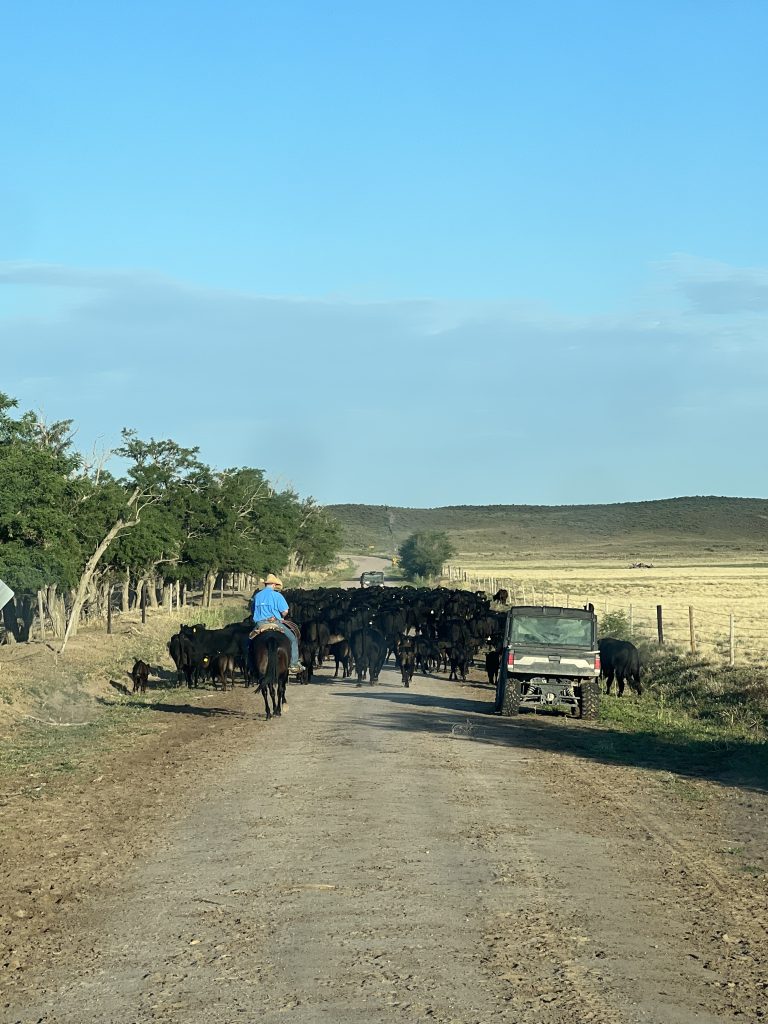Breeder’s Connection 2025 | Chundy Land and Cattle
Charles Jones moved to southwest Nebraska in 1894 from Illinois, starting a ranch along what would become the Chase and Dundy County lines. What started out as a Hereford herd slowly transitioned into a predominantly Angus operation. Now, the sixth generation is still farming and ranching in the same area. They raise corn, soybeans, and hay along with commercial and registered cows. Three generations of Jones’ are still working together. Stan and Phyllis Jones are slowly retiring. Their son Shawn and his wife Julie have three children: son Grant who is part of the operation; two married daughters Justin and Morgan Beierman, Jeff and Emily Gleisberg come back to help when they can.
“I was the crazy one who came back to the ranch,” Grant Jones said. “My dad started AI’ing in the early 1990s, and I bought the first registered Angus heifer in 2007 as a high school 4-H project. She was the start for our seedstock herd and her genetics are still in the herd.”
After graduating college and coming back to the ranch, Grant, along with his parents purchased Bob and Randy Martin’s pairs and formed Chundy Land & Cattle in 2016. “Chundy” stems from the combination of Chase and Dundy counties. The following year they held their first production sale in February at Imperial Auction Market.
“We purchased two females to use as embryo donors and started embryo transfers into our own recipient cows in 2020. We try to market 80 head of bulls each year, both registered Angus and SimAngus,” Grant said. “Our herd is very maternal-oriented. We strive to raise exceptional cows, and good bulls are the by-product. We are growing our female sales and currently offer 50 to 60 yearling heifers at our bull sale.”
“We strive to raise exceptional cows, and good bulls are the by-product.”
– Grant Jones
They offer a selection of yearling and coming two-year-old virgin bulls who are bred for success.
Chundy cattle calve in two groups. The January calving herd grazes as much as possible through December and then is brought closer and supplemented with hay until breeding. “We run them on rye for breeding and try to do as much like a commercial herd as possible with January calving. We built a hoop building with stalls, we try to run everything through the barn so we can record weights and vaccinations. Then they go back on corn stalks,” Grant said. “The spring herd are not pampered, they run out grazing 365 days a year on grass, corn stalks and rye.”
The Jones family raises all their own feed and operates a small backgrounding lot. The cattle are finished at yards in Nebraska and Kansas. They want a cow who can raise a big calf without being pampered or the calf fed creep feed.
“We raise strong cattle that will fit into the harsh environment of Southwest Nebraska – cows that will go out, raise and wean big calves,” Grant said. “[We strive for] truly functional females that will breed back all while being treated like commercial cows, with strong legs and good feet.”
They background all their own bulls with the older bulls summered out on grass. Ultrasound and carcass data is collected on each bull. They also utilize advanced genomic testing and enhanced genomic EPD data.
“We have built a fairly local customer base, with a lot of repeat buyers who are spreading the word. We want to produce a product that is worth mentioning to your neighbors. It might take a couple of years for producers to see how the bulls work and to see how the calves turn out, but 80 percent of our customers are repeat buyers,” Grant said. “We do not feed heavy and have good reports about bulls lasting longer than most. We develop bulls to last and try to give them ample space to exercise. I just talked to a customer and he still has a bull that is seven years old.”
The bull sale is held annually in March with past sales held at the Imperial Auction Market. The bulls all come with a first breeding season guarantee and they will keep the bulls until the end of April.
“We have recently started collecting data on the mature weight of cows at time of weaning to compare cows that are weaning a higher percentage of their weight. In the future, we plan to use this to cull and continue to find cows that can push the limits. We don’t necessarily want smaller cows but cows that weigh 1,350 to 1,450 pounds that continue to push calf weaning weights,” Grant said.
Grant believes strongly in maternal perfection. “True performance starts with the cow and only with her do we all remain in business. The number one economically produced trait to a cow/calf producer is reproductive performance.”
The 2025 Chundy Land and Cattle annual sale is scheduled for March 15. For more information, see chundylandandcattle.com.












